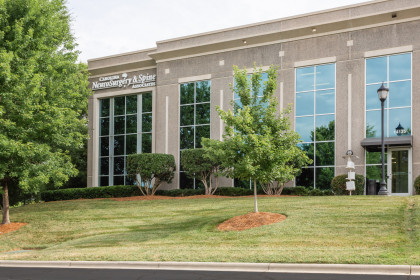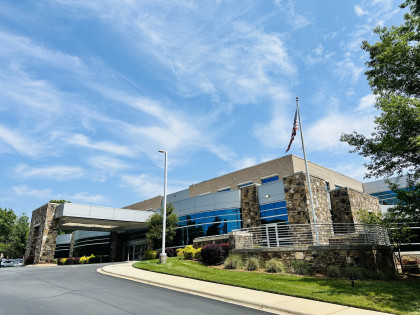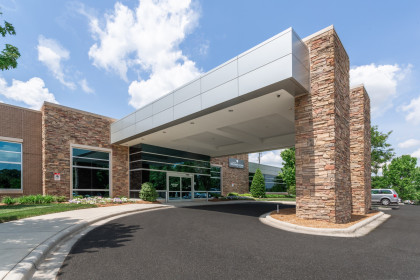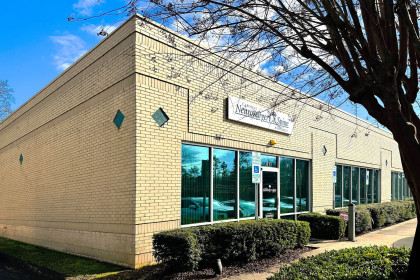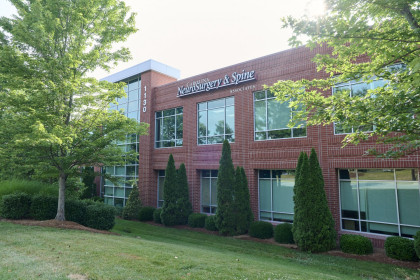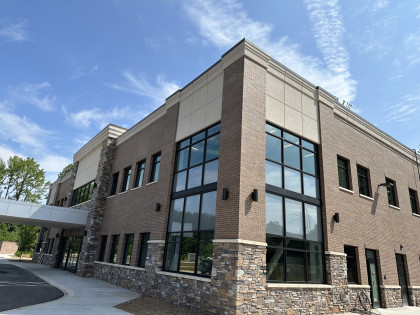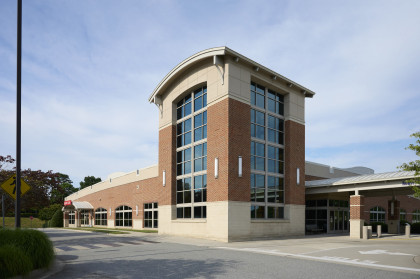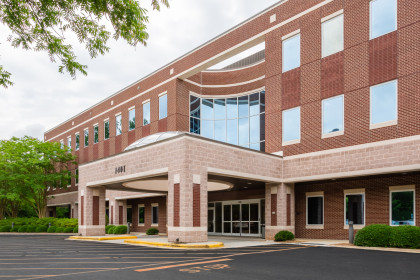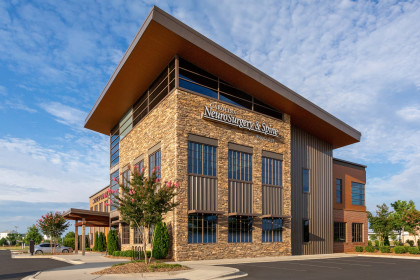Providing Comprehensive Spine Care at
CAROLINA NEUROSURGERY & SPINE ASSOCIATES (CNSA)
The Neurosurgeons at CNSA diagnose and treat a wide variety of adult and pediatric brain, spine, and peripheral nerve disorders, including having invented minimally invasive surgeries that greatly reduce recovery times when surgery is necessary, which we are proud to say are less than 50%. While pioneering the field of spinal surgery, we also teach our techniques to other doctors from around the world and are actively involved in clinical trials and academic studies.
Our spine experts meet with patients during your first appointment to perform a complete evaluation while exploring noninvasive therapies. Our physicians collaborate as a team to provide comprehensive spinal wellness with cutting-edge technology, techniques, and interventions. No matter what your spinal issue is, we are here to help you understand it better and find relief.
CNSA is a leader in minimally invasive spine surgery
Minimally Invasive Surgery (MIS) of the spine is a type of surgery on the vertebral (back) bones and their attachments that enclose and protect the delicate spinal cord. This type of surgery uses smaller incisions than standard surgery, which often causes less harm to nearby muscles and other tissues. It can also lead to less pain and a faster recovery after surgery.
- Cervical Microendoscopic Discectomy (MED) - Developed by Tim Adamson, MD, a CNSA practice neurosurgeon
- Lumbar Microendoscopic Discectomy (MED)
- Thoracoscopic Spine Surgery
- Minimally Invasive Transforaminal Lumbar Interbody Fusion (TLIF)
MIS of the spine is done by creating a smaller incision and inserting a tubular retractor. This instrument makes a tunnel to the problematic spine region, softly pulling aside the muscle and soft tissue around the location, which allows the surgeon to pass small tools into the tunnel to work on the spine. To guide themselves during the procedure, the surgeon additionally employs a specialized microscope and, real-time X-ray images, and even the utilization of intraoperative CT scan for navigation technique purposes.
Here at CNSA, we are leaders in the field of minimally invasive cervical, thoracic, and lumbar surgery. If you are struggling with back pain or any of the conditions mentioned here, reach out to us to schedule your consultation.
Surgical spine procedures
When MIS of the spine is not an option, the standard method of spine surgery is called open surgery. This uses a long incision down the back where the muscles and soft tissue around the spine would need to be moved away. In some cases, some tissue would need to be removed as well. Not all conditions can be treated with MIS, however, we will help to find your best and safest option.
- Artificial Disc Implantation (lumbar, cervical)
- Instrumented Spinal Fusions
- Anterior Discectomy & Fusion
- Anterior & Posterior Spinal Instrumentation
- Anterior Odontoid Screw Fixation
- C1-2 Transarticular Screw Fixation & Fusion
- Pedicle Screw Fixation
- Posterior Lumbar Interbody Fusion (PLIF)
- Transforaminal Lumbar Interbody Fusion (TLIF)
- Adult and Pediatric Scoliosis Surgery
neurologic and spinal conditions, injuries & deformities we treat
Deformity
A spinal deformity is an abnormal curve in your spine, like scoliosis or kyphosis. It can make it hard for your spine to do its job, which can cause pain, problems with your nerves, and trouble moving around
- Scoliosis
- Spina Bifida
- Tethered Cord
- Kyphosis
- Lordosis
Degenerative Spine Diseases
Degenerative disc disease occurs when the cushioning in your spine begins to wear away. The condition is most common in older adults. As we age, most people experience some spinal degeneration. The right treatment can lead to pain relief and increased mobility
- Disc Disease
- Disc Herniation/Slipped Disc
- Osteoporosis
- Spinal Stenosis/Spinal narrowing
- Spondylolisthesis
- Spine Fractures
- Spinal Trauma & Cord Injuries
Lumbar
Debilitating back pain is common and we are here to help with evaluation and treatment. Our team can help lead you to improved mobility and reduced pain.
- Spinal Reconstructions/Fusion
- Lumbar Discectomy
- Lumbar Artificial Disc Replacement (ADR)
- Lumbar MED
- Laminectomy
Cervical
Debilitating neck pain is common and we are here to help with evaluation and treatment. Our team can help lead you to improved mobility and reduced pain.
- Cervical spinal deformity reconstruction/fusion
- Anterior discectomy fusion
- Cervical artificial disc replacement (ADR)
- Posterior cervical microendoscopic discectomy
Pediatric
We have a team of medical experts to address any questions or concerns you might have because we understand how frightening this time can be.
- Spine Tumor
- Congenital Abnormalities
- Scoliosis
- Tethered Cord
Peripheral Nerve
If you're experiencing nerve issues not related to the brain or spine, look to us for solutions. Our team of specialists treats many other nerve issues.
- Pinched Nerves
- Sciatica
- Sacro-iliac disorders
- Compressive nerve disorders
- Carpal Tunnel
- Peroneal nerve
Tumor & Vascular
The spine can develop tumors and vascular anomalies anywhere along its length, including in the sensitive regions of the spinal canal.
- Laminectomy
- Resections
Spine Surgery faqs
What are the most common types of spine surgery?
Back surgeries come in a wide range of types, such as minimally invasive spine surgeries (MISS), fusions, laser, and robotic spine procedures. No matter what kind of spine surgery you may be considering for back or neck discomfort, educating yourself before deciding to have surgery will help increase the likelihood that the procedure will be successful
What does spine surgery recovery include at cnsa?
Because of the wide variety of spine surgery provided at CNSA, surgery recovery can range from going home the same day to taking several months, depending on the operation required. You will receive support from our doctors, surgeons, and physical therapists as you heal.
What is the difference between minimally invasive spine surgery and Traditional Spine Surgery?
Newer surgical techniques, including minimally invasive spine surgery and utilization of robotic techniques, are now available and can sometimes provide faster healing and less pain than traditional “open” spine surgery
Who is a good candidate for spine surgery?
Spine surgery can be an effective treatment for many people who are struggling with painful back and neck conditions. It is usually only performed after non-surgical treatments, such as physical therapy or steroid injections, have failed to work.
How do You Prepare for Spine Surgery?
If you and your surgeon have determined that your back or neck problem might be helped by surgery, there are several things you can do to help ensure that you are prepared for the procedure.
Depending on the surgery you are preparing for, there are some activities you should do to help strengthen the muscles in your back to help shorten your recovery time. Our team will help create a guide for each patient to ensure everyone receives the correct path of treatment for their unique condition.
Instructions for the day of spine surgery
Generally, you should not eat anything after midnight on the day of your surgery. On the day of your surgery, you may drink clear liquids for up to two hours before you arrive at the hospital. If your surgeon has instructed you to stay on a clear liquid diet before the day of your surgery, follow your surgeon's instructions.
What Should I Bring to My First Appointment?
Write down questions ahead of time so as not to forget. It’s important that you arrive at least 30 minutes before your appointment and if you can, bring someone with you for support.
Wear comfortable clothes that do not restrict your motion in case we need to test your skeletal and muscular abilities. Please bring any recent medical records, MRIs, CT scans, X-rays, or EMG reports that you have in your possession to your first appointment, as well as your insurance card.
The world of spine surgery continues to rapidly evolve as minimally invasive techniques provide relief for patients while providing significantly reduced recovery time. Surgeries that used to require the cutting of muscle and months of recovery can now be performed on an outpatient basis with incisions as smal as one inch. Minimally invasive spine procedures performed by Carolina Neurosurgery & Spine Associates includes:
- Cervical Microendoscopic Discectomy (MED) - Developed by a practice neurosurgeon
- Lumbar Microendoscopic Discectomy (MED)
- Thoracoscopic Spine Surgery
- Minimally Invasive Posterior Lumbar Interbody Fusion (PLIF)
Microendoscopic Discectomy (MED)
Herniated discs are the most common, and most painful, back ailment. At Carolina Neurosurgery & Spine Associates, patients with cervical disc herniations have a minimally invasive treatment option. In 1997, one of our spine surgeons, Tim Adamson, MD, modified technology designed for lumbar surgery and developed an innovative solution for the cervical spine. Microendoscopic discectomy (MED), requires only a one-half inch incision in the back of the neck, allowing muscles to be merely separated. There is significantly less pain for the patient, thus resulting in a much shorter recovery time.
Posterior Lumbar Interbody Fusion (PLIF)
The Traditional Procedure
Posterior Lumbar Interbody Fusion (PLIF) is a surgical technique for relieving compression of nerves and placing bone graft between adjacent vertebrae to achieve a fusion. Typically, screws and rods or other types of spinal instrumentation are used to hold the spine in position while the bone heals. Indications for a PLIF may include leg pain and back pain secondary to degenerative disc disease, spondylolisthesis, or recurrent herniated discs.
As with most minimally invasive procedures, the primary advantage is faster recovery for the patient. With traditional spinal fusion, a hospital stay of up to five days is needed, and recovery can take up to three months.
The Minimally Invasive Technique
Minimally invasive PLIF is an alternative to traditional, open spinal decompression and fusion. Minimally invasive PLIF achieves the same goals and objectives as the open surgery while minimizing trauma to the patient.
The procedure is performed through two one-inch incisions on either side of the lower back. The paraspinous muscles do not need to be stripped from the spine, there is less tissue retraction, and blood loss is minimized compared to the open procedure. Bone removal, a discectomy, an interbody fusion, and pedicle screw insertion can all be performed through the same small incisions. Therefore, tissue trauma and post-operative pain are reduced, hospital stays are shorter, and patients can recover more quickly.


